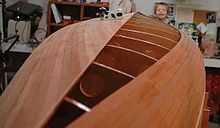Strip-built


Strip-built is a method of boat building commonly used for canoes and kayaks, but also suitable for larger boats. The process involves securing narrow, flexible strips of wood edge-to-edge around temporary forms.
These are the most popular among homebuilders. Some professional builders also offered both kits and finished boats. The canoes are constructed by gluing together 1/4" x 3/4" strips of wood over a building jig consisting of station molds that define the shape of the hull. The strips may be square cut, or for a better fit, they are shaped with bead and cove router bits. Once the strips are glued together, the inside and outside are sanded fair, and a fiberglass and epoxy covering is applied to the canoe inside and out. The fiberglass covering is transparent, allowing the wood strips to be seen. The strips are usually cedar, though sometimes pine is also used. Walnut or other contrasting woods are sometimes used as accent strips.[1]
The forms are cut as a series of cross-sections of the final design and set up along a "strong back" or other solid base. Stripping begins at the gunwale and finishes with "the football". The strips are edge-glued to each other, being held in place with nails, staples, or simply clamped to the forms. When the glue has dried, the nails/staples are removed and the rough hull is sanded smooth. It is then covered with a resin/epoxy impregnated overlay of fiberglass cloth, which is sanded and finished before removing the hull from the forms. The inside is then smoothed and similarly reinforced before seats, thwarts, and gunwales, are added to complete the boat.
This process is similarly suited to building kayaks. The strips are stapled onto a number of chipboard forms, the structures is sanded and fibreglassed, then the forms are removed and the hull is attached.
In the 1950s, this process for building canoes was adapted from ship/boat building techniques, and refined by a group of Minnesota canoe racers; primarily Eugene Jensen, Irwin C.(Buzzy) Peterson, and Karl Ketter.
References
- ↑ "How to build a cedar strip canoe". Compumarine.com. Retrieved 2012-09-20.